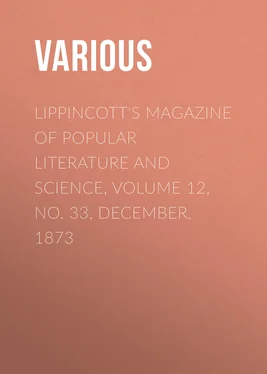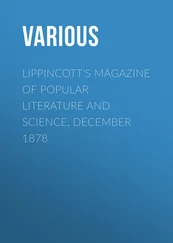Various - Lippincott's Magazine of Popular Literature and Science, Volume 12, No. 33, December, 1873
Здесь есть возможность читать онлайн «Various - Lippincott's Magazine of Popular Literature and Science, Volume 12, No. 33, December, 1873» — ознакомительный отрывок электронной книги совершенно бесплатно, а после прочтения отрывка купить полную версию. В некоторых случаях можно слушать аудио, скачать через торрент в формате fb2 и присутствует краткое содержание. Издательство: Иностранный паблик, Жанр: foreign_antique, periodic, foreign_edu, на английском языке. Описание произведения, (предисловие) а так же отзывы посетителей доступны на портале библиотеки ЛибКат.
- Название:Lippincott's Magazine of Popular Literature and Science, Volume 12, No. 33, December, 1873
- Автор:
- Издательство:Иностранный паблик
- Жанр:
- Год:неизвестен
- ISBN:нет данных
- Рейтинг книги:5 / 5. Голосов: 1
-
Избранное:Добавить в избранное
- Отзывы:
-
Ваша оценка:
- 100
- 1
- 2
- 3
- 4
- 5
Lippincott's Magazine of Popular Literature and Science, Volume 12, No. 33, December, 1873: краткое содержание, описание и аннотация
Предлагаем к чтению аннотацию, описание, краткое содержание или предисловие (зависит от того, что написал сам автор книги «Lippincott's Magazine of Popular Literature and Science, Volume 12, No. 33, December, 1873»). Если вы не нашли необходимую информацию о книге — напишите в комментариях, мы постараемся отыскать её.
Lippincott's Magazine of Popular Literature and Science, Volume 12, No. 33, December, 1873 — читать онлайн ознакомительный отрывок
Ниже представлен текст книги, разбитый по страницам. Система сохранения места последней прочитанной страницы, позволяет с удобством читать онлайн бесплатно книгу «Lippincott's Magazine of Popular Literature and Science, Volume 12, No. 33, December, 1873», без необходимости каждый раз заново искать на чём Вы остановились. Поставьте закладку, и сможете в любой момент перейти на страницу, на которой закончили чтение.
Интервал:
Закладка:
I have spoken of the gorgeousness of the Bangkok temples, but I must not forget to mention the colossal statue of Booddh that reposes in one of them. It is one hundred and seventy feet in length, of solid masonry, perfectly covered with a plating of pure gold, and rests quite naturally upon the right side, the recumbent position indicating the dreamless repose the god now enjoys in nirwâna . This is supposed to be the largest image of Gautama, the fourth Booddh, in existence, and it is an object of the profoundest veneration to every devout Booddhist.
Incremation of the dead is the custom in Siam, and while there I was present at several royal funerals, each marked by more lavish display of costly magnificence than we Americans ever see on this side the water. Shortly after I left the country occurred the death of the patriotic second king, so well and favorably known among us as Prince T. Momfanoi, the introducer of square-rigged vessels and many other improvements, and afterward as King Somdet Phra Pawarendr Kamesr Maha Waresr. The body was embalmed, and lay in state for nearly a year before the burning took place. The count de Beauvoir reached Bangkok just in time to see the royal catafalque, of which he gives a somewhat amusing account. He says: "The body, having been thoroughly dried by mercury, was so doubled that the head and feet came together, and after being tied up like a sausage was deposited in a golden urn on the top of the mausoleum." He speaks of the state officers in attendance by day and by night, and the dead king, from the golden urn on the very summit of the altar, holding his court with the same pomp and parade as during his life. A more affecting ceremony is the coming at noon and eve of the crowds of beautiful women, not yet absolved from their wifely vows, to converse with their loved and lamented lord, and the depositing of letters and petitions in the great golden basket at the foot of the mausoleum, with the confident expectation that these loving missives will reach the deceased and be answered by him. These royal catafalques are costly and magnificent, being covered with plates of gold, while the silks and perfumes consumed with a single body cost thousands of dollars.
M. de Beauvoir describes an interview with the king, surrounded by ten of his offspring, including the seventy-second child. I well remember the eldest son, the present supreme king, now in his twentieth year, looking when five years old the exact counterpart of this one—his graceful little figure, dimpled cheeks, eyes lustrous as diamonds, and the glossy, raven hair, close shaven at the back, while the foretop was coiled in a smooth knot, fastened with jeweled pins and twined with fragrant flowers. The dress was very simple—only two garments of silk or embroidered muslin—but the deficiency was more than made up by jewelry, of which, in the form of chains, rings, anklets and bracelets, he wore almost incredible quantities, while his golden girdle was studded with costly diamonds.
Polygamy prevails in its fullest extent in Siam, especially among those of noble or royal lineage; and the higher the rank the larger the number of wives, those of the supreme king amounting ordinarily to five or six hundred. Of these, the "superior wife" holds the rank of queen: she resides within the harem proper, where are the private apartments of the king, and her children are always the legal heirs. For the other wives or concubines, their children and attendants, there is a whole circle of buildings, connected by balconies with the palace royal. All these are handsomely fitted up, but what is called "the harem" pre-eminently is more gorgeous than our dreams of fairy palaces or enchanted castles of genii. Long suites of apartments with frescoed walls, ceilings of gold and pearl, floors inlaid with exquisite mosaics of silver and ebony, and with hangings of costly lace, velvet and satin, huge waxen candles, and lamps fed with perfumed oil that are never suffered to expire, mirrors, pictures, and statuettes innumerable, with cups, basins, and even spittoons, of pure gold,—all these are but a tithe of the lavish adornments of this Oriental paradise, where birds sing, flowers bloom, and the sounds of low sweet music ever greet the ear of the favored visitor. The accompanying engraving will give some idea of the general appearance of the entrance to the harem, with its burnished roof of green and gold, its graceful turrets and mosque-like pinnacles, and its base of pure white marble, chaste and elegant. But neither language nor pictorial illustration can convey to the mind any adequate realization of its bewildering beauty; and Count de Beauvoir but echoes the language of every traveler who has visited Bangkok when he declares, in his recent work, that "its temples and palaces are the most splendid of even the gorgeous East."
FANNIE R. FEUDGE.LIFE AT THE NATIONAL CAPITAL
There are few cities where life is so well put upon the stage as in Washington, so far as opportunity for satisfaction and enjoyment is considered. A certain grandeur characterizes all the approaches to the city. From the west you descend upon it by a way that leads out of cloudy mountain-chains and over chasms spanned by an awful trestle-work; from the south, passing our national Mecca, the Tomb of Washington, your highway is the picturesque Potomac, which here, nearly three hundred miles from the sea, broadly embays itself as if to mirror the magnificence of the place; from the north the track winds along the banks of the Delaware, white with its coastwise commerce, in and out among the beautiful bridges that arch the Schuylkill, across the broad Susquehanna, past blazing forges and foundries, and over the long and lonely expanses of the two Gunpowder Rivers—desert wastes of water, stretching for miles away without a sail, without a light, in the melancholy grandeur of a very dream of desolation. If it is at night that you step from the station, halfway down the distance you presently see the ray of a street-lamp throw up the façade of the Patent Office in broken light and shadow; you see before you and under the hill the twinkle of scattered groups of light; you see, far off, the long row of the Treasury columns half lost in darkness, and you will remember pictured scenes of bivouacs among the ruins of Baalbec. And if it is in the morning that you arrive, fresh from the turbulence of Broadway, from the quaint and tortuous hillside lanes of Boston, from the elegant monotony of Philadelphia, the impression made upon you is still not very different. Though you are in the heart of the place, it seems to lie before you like a city in the distance. Now the mist is stripped away from some massive marble pile; now a prospect opens of river and wood and the pillared heights of Arlington; now a lofty heaven reveals a waning moon, it may be—for every square has its horizon—the morning-star flames out, a red and yellow sunrise burns behind the silver cloud of the Capitol dome, and the whole city, in its splendor and its squalor, bared to view, gives you a suffocating sense of the pettiness of all other places before the opulence of sky, the width and height, the light and space and air, that Washington affords.
The concentric labyrinth of the city's plan is indeed something altogether unique; but whether it owes its origin to the fear of the old French barricade or to a desire for grandeur and scope, the effect attained is the same one of airy magnificence—monstrous avenues crossing the right angles of the streets in diagonals radiating from the White House and the Capitol, and all tiresomeness prevented by the accommodating way which these avenues have of turning out for any edifice that fancies their situation; while to keep upon them you are so perpetually crossing one street or losing your way down another that you may almost imagine yourself a spider walking across a web.
Читать дальшеИнтервал:
Закладка:
Похожие книги на «Lippincott's Magazine of Popular Literature and Science, Volume 12, No. 33, December, 1873»
Представляем Вашему вниманию похожие книги на «Lippincott's Magazine of Popular Literature and Science, Volume 12, No. 33, December, 1873» списком для выбора. Мы отобрали схожую по названию и смыслу литературу в надежде предоставить читателям больше вариантов отыскать новые, интересные, ещё непрочитанные произведения.
Обсуждение, отзывы о книге «Lippincott's Magazine of Popular Literature and Science, Volume 12, No. 33, December, 1873» и просто собственные мнения читателей. Оставьте ваши комментарии, напишите, что Вы думаете о произведении, его смысле или главных героях. Укажите что конкретно понравилось, а что нет, и почему Вы так считаете.












